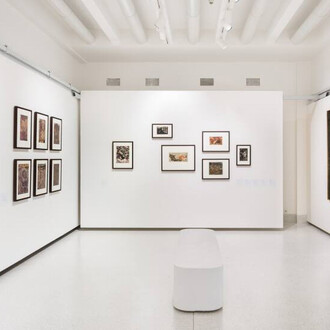“Taking up the work of other people allows you a kind of contact even at a distance, a genealogy, a form of complicity and knowledge.” These are the terms in which Azucena Vieites (Hernani, 1967) speaks of a work that consists of approaching contemporary visual culture by means of strategies like citation, appropriation, inverventions centered on the idea of the original and the copy, processes of resignification, and the feminist thought and gender politics associated with subcultures. Her oeuvre might be considered a kind of DIY remix that attempts to represent a memory in relation to a present time and to an experience of passage, a memory whose intensity will gradually fade.
In Tableau vivant, Azucena Vieites lays out a series of silkscreen prints based on pre-existing images, along with a series of drawings by the artist that were colored in by the participants in Coloring Book, a children’s workshop held prior to the opening of the exhibition. Also included are a video piece and a series of projections, the artist’s first incursion in this field, which enter into a dialogue with the other two series. Seen here to be of major importance in her production are multiplicity, fragmentation and repetition as means of breaking away from the absolute image and linear narrative forms, and central too is the ephemeral and processual nature of her work.
The title, Tableau vivant, alludes to painting, to certain forms of dance, and to an idea of “frozen” representation in a setting or framework where a group of characters pose, recreate, simulate an event or a scene. Other aspects of such a work include the idea of entertainment, that of mixture, and the construction of a visual iconography where pleasure, excess and fantasy are implicit. The artist is interested in the tableau vivant as a way of acting and thinking that relates back to a technique used by filmmakers like Ulrike Ottinger, whose work she acknowledges. In the German film-maker’s words, “every film for me possesses a certain form that has to do with colors, with time, with dramatic structure, with the way of linking the images. And so in every film I work to find the right form.”
The silkscreen prints present a series of collages that might configure a fanzine opened up on the wall. As an editorial and creative activity, the fanzine questions the idea of ‘professionalism’ in embracing a project that employs a ‘low-fi’ aesthetic. It belongs to the DIY culture, which has its genealogies in other social and artistic movements like dadaism, punk or the feminist liberation movement. Used by very heterogeneous groups, this means of expression makes it possible to produce and document representation itself. Vieites’ continuous work with Erreakzioa-Reacción, a feminist art project that arose in 1994, is framed within these premises. Added to this are the results of the children’s workshop, aimed at observing and learning from the capacity for surprise, lack of convention and urge to construct language at early ages. The technique of silkscreen allows her to translate images, in this case through the use of four-color printing, and so obtain a version that casts a new gaze upon them. In her own words, “serigraphy allows me to obtain an image time and time again, and as a technique it makes us think about the notions of the original, the copy, and the unique and the serial or reproducible artwork. Under the effect of repetition, what is represented changes and fades away. The image is constructed on the basis of that reiterative effect. In the interstices, there occurs something which exceeds the representation itself and makes it strange.
From my point of view, one of the reasons behind artistic practice has to do with the capacity to provoke a sense of strangeness.” A similar dynamics is proposed for her work with moving images. The remixing of “any images”, which will never be the same as “just any image”, gives rise to a video piece whose points of reference range from the most experimental productions in the medium to others that are closer to the language of the music videoclip.
Museo Nacional Centro de Arte Reina Sofía
Santa Isabel Street, 52
Madrid 28012 Spain
Ph. +34 91 7741000
info@museoreinasofia.es
www.museoreinasofia.es
Opening hours
Monday to Saturday 10.00am - 9.00pm
Sunday 10.00am - 7.00pm. ( 2.30 - 7.00pm Collection 1 and 2)
Tuesday closed (including holidays)














